Your bathroom should be as stylish as it is practical—and great lighting plays a big role in achieving both. After all, it’s the light you see yourself in each morning and the one you turn off at night. But with so many options, how do you choose the right lighting? Our bathroom lights guide is here to help.
Every bathroom needs vanity lighting, but the rest depends on your layout and personal style. If you have space beside your mirror, wall sconces offer a flattering, focused light that’s perfect for grooming. Limited on wall space? A vanity light bar above the mirror can provide the illumination you need. And if your setup allows, lighted mirrors are a sleek, functional upgrade worth considering.
Small Bathroom Lighting Ideas That Work
Once a strictly utilitarian space, the modern bathroom has evolved into a personal sanctuary—a place to energize yourself in the morning and unwind in the evening. As highlighted in ‘Everything to Know About Bathroom Design’, one of the most important elements in creating a functional and luxurious space is lighting. Just like in the kitchen, bathroom lighting works best in layers: ceiling fixtures for ambient light, vanity lighting for daily grooming, specialty lights for the shower, tub, and toilet area, mood lighting for a spa-like feel, and soft, low lights for nighttime use. These thoughtful lighting layers are among the essential features for modern master bathroom.
To help you create the perfect lighting setup, we’ve put together a bathroom lights guide covering different styles, placements, and ideas tailored to your space.
How much light do you need?
At its brightest, to provide the best washing and grooming environment, the bathroom lighting scheme should replicate daylight—or even better, include natural light by way of a window or skylight. When considering how many lights in a bathroom are necessary, it’s important to balance artificial lighting with any available natural sources. Adding (actual) natural light can also cut utility costs. A quick trip to the loo and a stop at the sink to wash your hands probably doesn’t require turning on the lights if your bathroom has a window or skylight. These principles are key to many modern master bathroom ideas, where bright, natural illumination plays a central role in creating a fresh, inviting space.
A well-designed bathroom lighting scheme, as highlighted in this bathroom lights guide, can also impact safety and comfort, especially for older occupants. As we age, our eyes require more light to see; a 60-year-old needs three times more light to see than a 20-year-old. Not only does better lighting make the act of seeing more comfortable for older people, but it can also prevent accidents and falls—80% of falls among seniors happen in the bathroom.
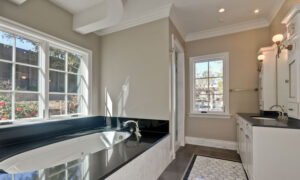 This traditional master bath uses all of the same concepts as the image above: well-spaced recessed ceiling lights, vanity lights on either side of the mirror, and a ton of natural light spilling over the bathtub.
This traditional master bath uses all of the same concepts as the image above: well-spaced recessed ceiling lights, vanity lights on either side of the mirror, and a ton of natural light spilling over the bathtub.
For the most versatile bathroom lighting configuration, put at least some of the fixtures on a dimmer switch. Additionally, consider small bathroom lighting ideas that can help optimize light without overwhelming the space, creating a balance between functionality and ambiance.
Choosing a better bathroom bulb
Creating the proper amount of light in a bathroom is not so much about adding more fixtures, but about the proper placement covered later in this bathroom lights guide and guide to under cabinet lighting of better fixtures and bulbs.
Fixtures should have frosted white shades to create the most even and flattering light. When deciding how many lights in a bathroom are ideal, consider the type of bulbs and the lighting effect you want to achieve. Traditional incandescent bulbs (not recommended) should have a color temperature between 2700K and 3000K. Bulbs should be at least 100W, but you could comfortably have up to 150W if you like really bright task lighting. If you’re looking for the brightest light bulb for bathroom use, make sure to choose LEDs that offer a CRI of at least 90, a color temperature between 2700K and 3000K, and at least 1600 lumens (equivalent to a 100W incandescent bulb). Not all LED bulbs offer the full temperature and brightness range, so check the specifications before buying.
Not all LED bulbs offer the full temperature and brightness range, so be sure the LEDs you choose for your bathroom offer a CRI of at least 90, temperature between 2700K and 3000K, and at least 1600 lumens (equivalent to a 100W incandescent bulb).
Looking for inspiration on how great lighting can transform a space? Check out Our Portfolio for examples of spaces we’ve designed with attention to lighting and details, like the sleek design of Eclectic bathrooms that complement the lighting in every room.
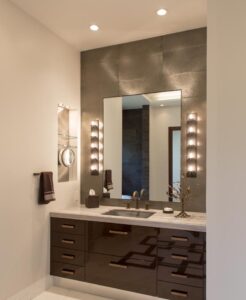
Like the glam look of the old “Hollywood” vanity bar but don’t like the incandescent bulbs? These fixtures use LEDs! Note the detail lighting for the built-in shelving on the left.
The do’s and don’ts of ceiling lighting
The first most common mistake made when lighting a bathroom is not providing enough light. The second is relying too heavily on recessed lighting. The ceiling lights will provide the majority of the light in the room, but using too many recessed ceiling lights will make your ceiling look like a slice of Swiss cheese. How many fixtures you need depends on the area of the bathroom and the height of the ceiling. A general rule of thumb, often mentioned in any comprehensive bathroom lights guide, is to place ceiling lights at a distance of 50% of the ceiling height. So if you have an eight-foot ceiling, the fixtures should be four feet apart.
Ceiling lights should be symmetrically positioned throughout the room over the primary walkways. Don’t mount ceiling lights too close to the vanity or you’ll create uncomfortable shadows on the face. For more home lighting inspiration beyond the bath, many of our projects feature sleek Contemporary Bathroom that pair beautifully with modern lighting layouts.
Sconce vs. bar—or both?
Vanity lighting isn’t all about vanity. When thinking about how many lights in a bathroom you need, especially around the mirror, consider function and placement. Correctly placed sconces and a lighting bar above the mirror make daily tasks like applying makeup and shaving easier and more comfortable by casting a smooth, even light across the face, eliminating the awkward shadows created by ceiling lights. These lighting decisions, along with elements like faucet styles and types of sink mounts, all contribute to both the functionality and aesthetic of your bathroom.
To create the best vanity light, sconces should be mounted on either side of the mirror at least 28 inches apart. The center of the sconce should be at eye level, approximately 66 inches above the floor. A light bar above the mirror should be mounted approximately 78 inches above the floor.
Looking for an alternative to the typical sconce? Some companies are designing vanity mirrors with built-in LED lighting. Mirrors with built-in overhead lighting bars are typically adjustable to cast the right amount of light on the user, regardless of height. These lighting upgrades pair beautifully with Modern Bathroom Cabinets and the clean, elegant look of Modern Bathroom Vanities – Silk, creating a bathroom that’s both stylish and functional.
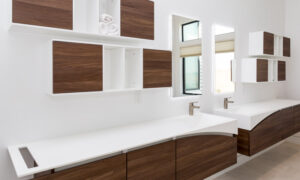
These minimalist mirrors from BMT Bagni feature built-in LED task lighting for him and her.
Lighting for the shower, tub & WC
The shower, bathtub, and (if you have one) the water closet all need to have dedicated lighting. At the very least, you’ll want to have one or two ceiling lights in these areas depending on how large they are. Since water closets are typically small spaces, a light/fan combination fixture is a good choice. For more insights on optimizing these compact spaces, refer to our guide to buying a toilet, which covers everything from space-saving designs to modern features.
In the shower, you’ll generally want to use a recessed or dome ceiling light with a trim designed to keep moisture out of the fixture in a wet environment. When shopping for bathroom lighting, look for lights specifically rated for use in the shower. If you’re aiming for the brightest light bulb for bathroom use in these areas, make sure it’s safe for damp or wet locations and provides enough lumens for clear visibility.
In the case of the shower and bathtub, you may also want to add mood lighting. There are a number of products available for shower mood lighting, including specially designed fixtures that can cast several different colors of light—yellow to wake you up, green to create a sense of harmony, or purple to excite you—and showerheads with built-in LED mood lighting.
Building codes in many places prohibit open or hanging lights within eight feet overhead of bathtubs or whirlpools. To create a romantic atmosphere, you could mount decorative sconces on the sidewalls or place a skylight with an open view of the stars above the bath. These ideas align perfectly with the innovative concepts behind Blues 4.0 bathrooms, which emphasize wellness, ambiance, and high-tech comfort.
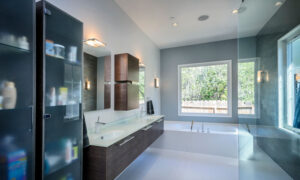
This bathtub is surrounded by natural light, but the elegant wall sconces create a romantic evening mood.
Show off your personality
When it comes to bathroom lighting, there are as many options as there are for the rest of the house. Whether your style is modern or traditional, contemporary or transitional, choosing unique fixtures or finishes will upgrade the level of sophistication in your bathroom. For inspiration and best practices, a bathroom lights guide can help you navigate fixture types, placement, and lighting temperature to achieve both function and beauty.
You might want to have a few recessed ceiling lights for general ambient lighting, but a decorative chandelier adds style and personality. Put the chandelier on a dimmer switch to create a relaxing mood at the end of the day. These thoughtful lighting choices align perfectly with the refined aesthetics seen in Lamé Bathrooms, where elegance and functionality come together seamlessly.
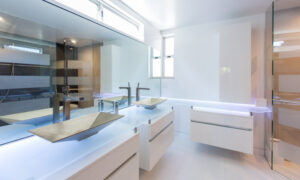
This massive mirror has built-in LED lighting that is not only dimmable—the color can be changed as well.
Don’t forget the nightlight!
No one wants to step into a fully lit bathroom in the middle of the night, and nor is it necessary. While bright bulbs for bathroom use are great during the day for tasks like grooming or makeup application, nighttime calls for softer, more subtle lighting. Bathroom night lighting can be as simple as a portable night light strategically plugged in or a dimmable ceiling light on a dedicated switch that can be left on at night.
More sophisticated options include a strip of lighting mounted at the toe kick of the cabinets that illuminates when there’s not enough ambient lighting or a designated light on a dimmable switch activated by a motion sensor. There are even wall outlets available with integrated night lights that turn on and off depending on how much ambient light is in the room. These smart lighting solutions are perfect examples of how Hi-Tech bathrooms blend convenience with cutting-edge technology for modern living.
Key Components of Bathroom Lighting
Let’s see what goes into great bathroom lighting. This bathroom lights guide breaks down the key components you’ll want to consider for a space that’s both functional and stylish.
Bathroom Ceiling Lights
Ceiling lights play a key role in providing overall illumination in the bathroom. Overhead fixtures like flush mounts or recessed downlights are ideal for creating a bright, well-lit space. When planning your bathroom design, it’s important to think about your lighting needs early on. This helps you identify the features you want to highlight and allows you to include options for softer, mood-enhancing lighting as well.
Bathroom Wall Lights
Wall-mounted lighting—like sconces and vanity fixtures—offers targeted brightness for grooming and makeup routines. Placing them on either side of your mirror ensures even, flattering illumination. Layering your lighting with wall lights can soften the space and create a more welcoming vibe. Try using them alongside ceiling lights to bring depth and warmth to the overall design.
Bathroom Task Lighting
Task lighting focuses on areas where precision matters, such as shaving or trimming nails. Options like pendant lights or recessed fixtures work well for this purpose. The key is to choose lights that are bright enough for visibility but soft enough to avoid glare. Thoughtful planning and placement of task lighting can significantly enhance both functionality and aesthetics in your bathroom renovation.
Bathroom Ambient Lighting
Ambient lighting plays a crucial role in setting the mood and atmosphere of your bathroom. For a calming environment, consider using dimmable fixtures or indirect lighting methods. It’s important to select lighting with the appropriate IP rating, depending on its proximity to wet areas. This bathroom lights guide recommends choosing fixtures with the correct IP rating based on the zone in which they will be used.
Bathroom Accent Lighting
Accent lighting is designed to highlight architectural features, artwork, or other decorative elements within your bathroom. To add visual interest, use LED strip lights or adjustable spotlights. Adding a second layer of lighting with bathroom wall lights can enhance the overall ambiance of your space. This bathroom lights guide shows how to use accent lighting to transform your room into a more inviting and stylish area.
Conclusion
This bathroom lights guide emphasizes the importance of thoughtful lighting design to create a functional, safe, and aesthetically pleasing bathroom. By considering factors like proper fixture placement, bulb selection, and layering light in different zones of the room, you can achieve the ideal lighting for your needs. Whether you’re seeking bright, daylight-like lighting for grooming, mood lighting for relaxation, or practical solutions for nighttime use, the right choices will enhance both the beauty and safety of your bathroom. Keep these tips in mind as you plan your bathroom lighting to ensure a space that combines both style and functionality.



